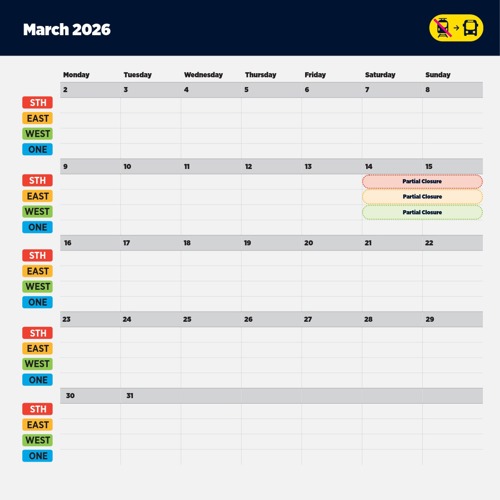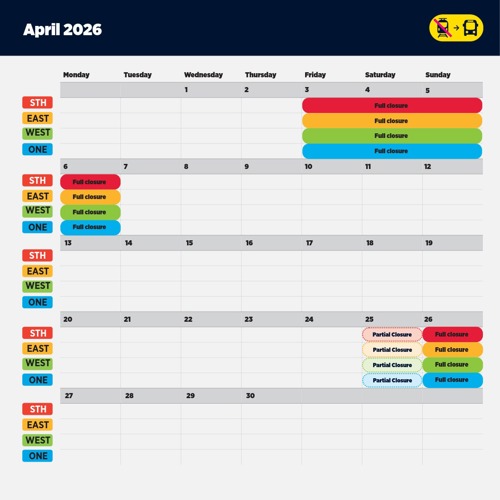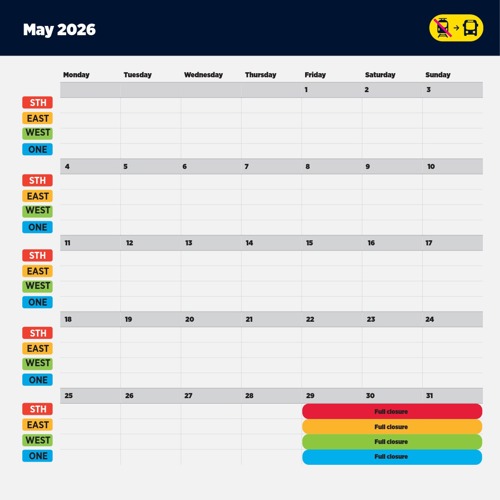Planned rail closures Planned rail closures
The rail network needs regular maintenance and upgrade works to allow for a more frequent, faster and reliable network into the future.
On this page
When work is happening on a train line, we need to close sections of the track. We try to do this when fewer people are using the trains – including overnight and during holiday periods.
This page shows a long-term forecast of current planned rail closures. Exact details of closures (e.g. timing) and alternative transport options are confirmed ~3 months in advance and are often dependent on what happens during other works. Please note that plans can also be affected by weather or other incidents on the network so may be subject to change.
As well as these closures for planned maintenance and upgrade works, from time to time there are additional urgent or emergency closures.
For the most up-to-date information on the day of travel including more specific details and alternative transport options, please check Train Line Status before you travel and subscribe to push notifications in the AT Mobile app.
Planned rail closure calendar
Guide:
- Full line closure means the entire train line is closed. There will usually be rail replacement buses organised.
- Partial closure means only a part of the line is closed. Trains will continue to run on the rest of the line and there will usually be rail replacement buses organised for the closed section of the line.
- Reduced frequency means that trains will run less often (e.g. running every 20 minutes instead of every 10 minutes), to allow lines to stay open whilst works are happening.
- Night works work will happen overnight so that trains can continue to run during the day. The last few services of the night will usually be cancelled, to allow workers to get as much done as possible overnight.
Last updated 9 December 2025
December
(Click the calendar to enlarge)
Western line: Partial closure between Swanson and Henderson, and a reduced frequency from Tuesday 28 October to Friday 26 December.
Southern line: Full closure for nightworks will be in place from 9:30pm on Monday 1, Sunday 7, Monday 8 and Thursday 11 December.
Eastern Line: Full closure for nightworks will be in place from 9:30pm on Sunday 7 and Thursday 11 December.
Onehunga Line: Full closure for nightworks will be in place from 9:30pm on Monday 1 and Monday 8 December.
All lines: Full network closure from Saturday 27 December 2025 to Sunday 18 January 2026. Some services resume between 19 January to 26 January 2026. Full closure 27 – 28 January 2026.
January 2026
(Click the calendar to enlarge)
Western Line: Full line closure from Saturday 27 December 2025 to Wednesday 28 January 2026.
Southern Line: Full line closure from Saturday 27 December 2025 to Sunday 18 January 2026. Limited Southern Line trains return from Monday 19 January to Monday 26 January 2026, running only between Newmarket to Puhinui, and to Manukau. Full line closure for City Rail Link testing from Tuesday 27 January to Wednesday 28 January.
Eastern Line: Full line closure from Saturday 27 December 2025 to Sunday 18 January 2026. Limited service on the Eastern Line returns from Monday 19 January to Monday 26 Trains only running only between Otahuhu to Manukau and served by Southern Line trains. Full line closure for City Rail Link testing from Tuesday 27 January to Wednesday 28 January.
Onehunga Line: Full line closure from Saturday 27 December 2025 to Sunday 18 January 2026. Onehunga Line services resume from Monday 19 January to Monday 26 January 2026. Full line closure for City Rail Link testing from Tuesday 27 January to Wednesday 28 January.
February 2026
(Click the calendar to enlarge)
Southern Line: Full closure from 6 to 8 February 2026. Full closure from 28 February to 1 March 2026.
Eastern Line: Full closure from 28 February to 1 March 2026.
Western Line: Full closure from 6 to 8 February 2026. Partial closure between New Lynn to Swanson from 28 February to 1 March 2026.
Onehunga Line: Full closure from 6 to 8 February 2026.
March 2026
(Click the calendar to enlarge)
Southern Line: Full closure from 28 February to 1 March 2026. Partial closure between Puhinui to Pukekohe from 14 to 15 March 2026.
Eastern Line: Full closure from 28 February to 1 March 2026. Partial closure between Waitemata to Otahuhu with Otahuhu to Manukau being served by the Southern Line from 14 to 15 March 2026.
Western Line: Partial closure between New Lynn to Swanson from 28 February to 1 March 2026 and 14 to 15 March 2026.
Onehunga Line: Normal operations.
April 2026
(Click the calendar to enlarge)
Southern Line: Full closure from 3 to 6 April 2026. Partial closure between Puhinui to Pukekohe from 7 to 12 April 2026. Partial closure on 25 April, with trains only running until 2pm then full closure on Southern Line. Full closure 26 April 2026.
Eastern Line: Full closure from 3 to 6 April 2026. Partial closure between Waitemata to Otahuhu with Otahuhu to Manukau being served by the Southern Line from 7 to 12 April 2026. Partial closure on 25 April, with trains only running until 2pm then full closure on Eastern Line. Full closure 26 April 2026.
Western Line: Full closure from 3 to 6 April 2026. Partial closure on 25 April, with trains only running until 2pm then full closure on Western Line. Full closure 26 April 2026.
Onehunga Line: Full closure from 3 to 6 April 2026. Partial closure on 25 April, with trains only running until 2pm then full closure on Onehunga Line. Full closure 26 April 2026.
May 2026
(Click the calendar to enlarge)
Southern Line: Full closure from 29 to 31 May 2026.
Eastern Line: Full closure from 29 to 31 May 2026.
Western Line: Full closure from 29 to 31 May 2026.
Onehunga Line: Full closure from 29 to 31 May 2026.
Travelling during rail closures
Visit Train Line Status to see upcoming rail closures, including whether there are rail replacement buses and their timetables. When there is an unplanned closure, the information will be updated in real time on the Train Line Status page.
You can use Journey Planner and the AT Mobile app to find other ways to travel when trains are not running.
Rail replacement buses
During larger planned closures, AT organises rail replacement buses. These buses stop at all stations on the closed line (or closed part of the line).
Rail replacement buses show up in the AT mobile app as bus services (not trains) and use the following names:
![]() RBE: Rail Bus Eastern
RBE: Rail Bus Eastern![]() RBS: Rail Bus Southern
RBS: Rail Bus Southern![]() RBO: Rail Bus Ōnehunga
RBO: Rail Bus Ōnehunga ![]() RBW: Rail Bus Western
RBW: Rail Bus Western
You may also find one of our existing bus routes suits your journey better. To view a station’s alternative transport options, visit our train station maps page.
You can also download the AT Mobile app and subscribe to alerts for your train line. We'll notify you about changes to your line and alternative transport options.
You can use all valid train tickets and passes to travel on rail replacement buses. Buses cannot carry bikes, scooters, or large personal items.
Find out more about buses replacing trains.
View train station maps and railbus stop locations.
Replacement bus wheelchair and mobility scooter accessibility
Customers with large wheelchairs or mobility scooters can take a free mobility taxi. Phone us on 09 366 6400 to book one.
To find out more about accessible bus travel, visit our Bus accessibility page.
About our rail maintenance work
Maintaining the rail network is important to keep everyone safe. Our work programme ensures that the tracks, overhead powerlines and structures like bridges or tunnels are maintained.
When work is being done on the network, the power lines overhead need to be shut off so that workers can operate safely below. These powerlines are connected to whole segments of the tracks, so even if a very small area needs to work, we sometimes need to close off larger areas, affecting multiple stations.
Rail Network Rebuild
Auckland’s rail network is undergoing a major upgrade to get ready for the opening of the City Rail Link (CRL) in 2026. We need to upgrade the tracks and foundations (some of which are hundreds of years old) to be ready for faster and more frequent services.
Learn more about the Rail Network Rebuild.
Information is correct at the time of publishing and subject to change.





